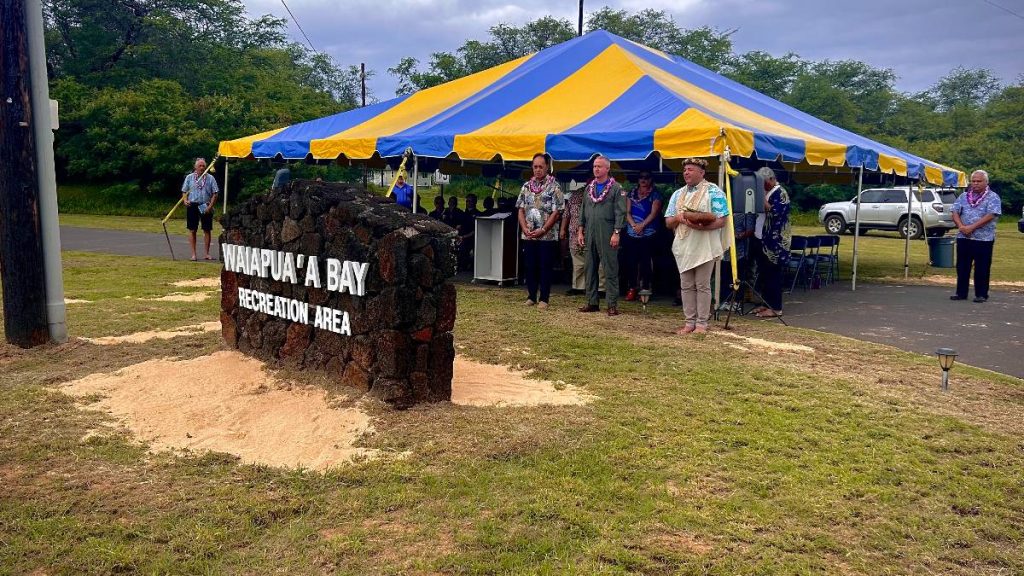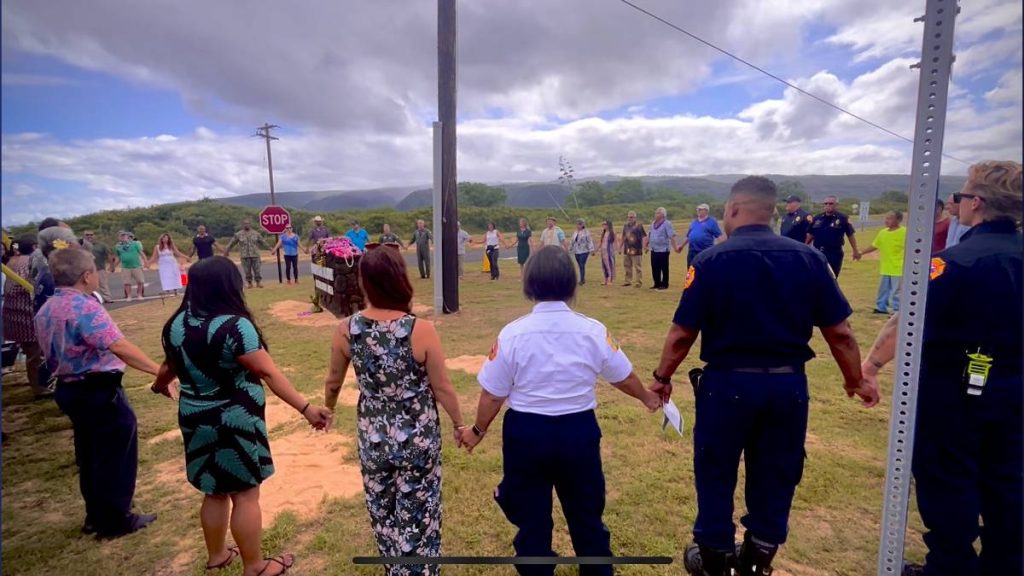Deprecated: stripslashes(): Passing null to parameter #1 ($string) of type string is deprecated in /mnt/efs/html/wp-content/plugins/template-scripts/src/AuthorBios/Frontend.php on line 129
PMRF honors Hawaiian place name as Major’s Bay becomes Waiapua‘a Bay
The US Navy’s Pacific Missile Range Facility in Kekaha formally changed a recreation area at its military base to its Native Hawaiian place name during a sign unveiling ceremony on Friday, May 31, as Major’s Bay officially became Waiapua‘a Bay.
Approximately 40 people attended the ceremony, which included speeches from PMRF staff, county officials, and cultural advisors, beginning with a welcome oli (Hawaiian chant) and pule (prayer), led by Kumu Hula (master hula teacher) Troy Allen Hinano Lazaro.

Lazaro emphasized the significance of restoring the ancient name to honor Native Hawaiian ancestors, expressing gratitude for the change.
“I feel so privileged and each and every one of you should too because you are here on a remarkable day.
“A day that we gather and ask for God’s blessings that this inoa (name) will not just be restored but will live on for the generations to come,” Lazaro said.
E. Kalani Flores, a Hawaiian cultural practitioner, later discussed the history and cultural importance of Native Hawaiian place names for connection and understanding.
“It connects us all, whether you’re Hawaiian or not,” Flores said. “It connects us to all these aspects of the Kanaka (Native Hawaiian people) that dwelled in these lands, fished in these lands, hunted in these lands, farmed in these lands,” he added.

According to Flores, the name Waiapua‘a means “the water of the pig.”
“Why? I don’t know,” he said. “There has to be a reason why this name was given here. But it is connecting us to this wahi pana (legendary place).”
PMRF Deputy Public Works Director Thomas Nizo said the organization has wanted to change the name for at least a couple of years but was finally able to coordinate everything in the last six months through the help of PMRF Commanding Officer Capt. Brett Stevenson.

In his welcome speech, Stevenson emphasized that the formal change to Waiapua‘a was crucial for fully acknowledging the island’s history.
Waiapua‘a would now be included in the growing list of Native Hawaiian place names across the island, he noted.
“We weren’t all here when we began this journey. But it feels pretty good to see it cross the finish line,” Stevenson said.
“We move forward with a spirit of unity and humility, inspired by the resilience and wisdom of those who came before us. Let us all remember, the names we use, the stories we tell, and the histories we honor are powerful,” he said during the address.

Kauaʻi County Council Chair Mel Rapozo and Vice Chair Kipukai Kualiʻi presented a certificate to recognize PMRF for returning Major’s Bay to Waiapua‘a Bay, its original and earliest place name on record.
“Our next generation will not know this as Major’s Bay. To me, that is incredible,” Rapozo said.
“Some might think of a sign unveiling as a very insignificant thing. This is much more than that. This is restoring the name and the history.”
Kuali’i shared similar sentiments.
“We need to know and it’s a matter of respect and appreciation,” he said.
The speeches were followed by the sign unveiling, as PMRF staff revealed the new Waiapua‘a Bay sign.

Attendees gathered to place leis on the new sign, sang Native Hawaiian songs, and held a pikai ceremony, a Hawaiian ritual where salt water was sprinkled over the sign to purify and cleanse the area.
Following the ceremony, Christian Gutierrez, a firefighter EMT with PMRF, told Kauaʻi Now that it was incredible to be part of the unveiling and learn more about Native Hawaiian culture.
“I actually saw the sign kind of being worked on these past few months and I always wondered what was going on and when I heard they’re gonna unveil everything, I was really excited,” said Gutierrez, who is from Nevada.
“Learning about the culture and stuff was a big thing for me coming out here, especially not being from here. I think it’s very important that I take part in things like this, like an unveiling ceremony, and learn the names behind every beach out here.”

Sponsored Content
Notice: Function the_widget was called incorrectly. Widgets need to be registered using
register_widget(), before they can be displayed. Please see Debugging in WordPress for more information. (This message was added in version 4.9.0.) in /mnt/efs/html/wp-includes/functions.php on line 6114










